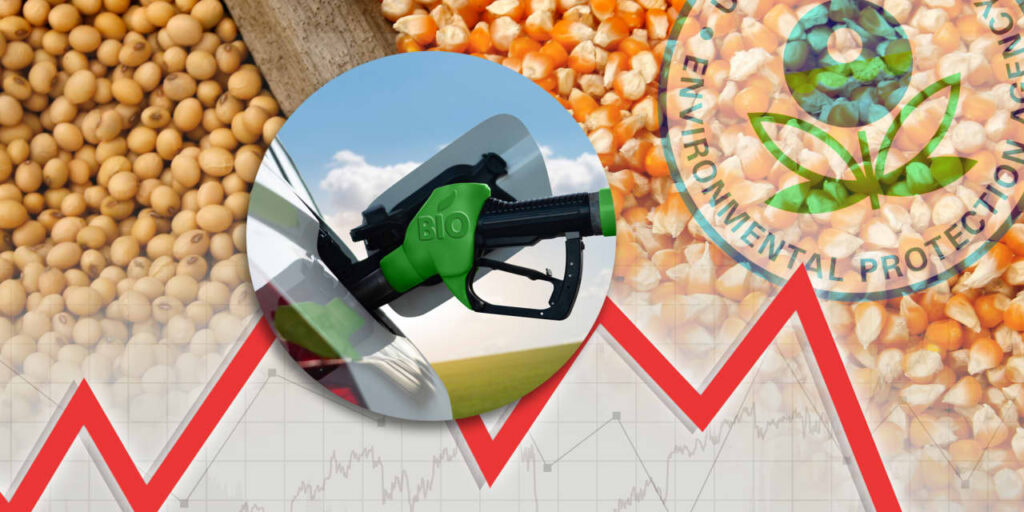Corn and soybean prices have declined on the back of excess supplies, with disappointing U.S. mandates for plant-based renewable fuels contributing to weakness — and pulling prices for both down by roughly 8% in the first few weeks of the year.
“The ethanol market for corn, and renewable diesel market for soybean oil, are two much-needed sources of demand in a year in which row crop prices are distressed by plentiful supplies,” said Todd Hultman, market analyst at DTN.
The U.S. government’s Renewable Fuels Standard program requires transportation fuel sold domestically to contain a minimum volume of renewable fuels. It started with the Energy Policy Act of 2005 and was expanded and extended with the Energy Independence and Security Act (EISA) of 2007.
The EISA created “huge demand for ethanol and biodiesel, which in turn created enormous demand for corn and soybeans used to create ethanol and biodiesel inside the U.S.,” said Sal Gilbertie chief executive officer at Teucrium. As a result, the trading ranges for corn prices roughly doubled from what they were prior to the passage of the 2007 act, he said.
EPA mandates
But every few years, the U.S. Environmental Protection Agency sets minimum volume requirements for biofuel use, updating the levels based on its assessment of market conditions, current and anticipated supply availability of varying biofuels, and political pressures, said Gilbertie.
In June of last year, the EPA released new standards that were higher than in prior years, but below industry expectations, he said.
The EPA regulations set last June require refiners to blend 21.54 billion gallons of renewable fuel in 2024 and 22.3 billion gallons in 2025. Those are down 330 million gallons and 350 million gallons from what was previously proposed for 2024 and 2025, according to report from S&P Global Commodity Insights.
Ethanol is blended into gasoline, mainly at a 10% concentration, while biodiesel is blended into diesel fuel in concentrations ranging from 5% to 20% — and that blending reduces demand for petroleum, said Brian Milne, DTN analyst and editor.
Overall, the federal program has been a “success” from the standpoint that it greatly expanded demand for ethanol and biodiesel, he said.
There is disappointment, however, among biofuel producers in that the 10% concentration of ethanol in gasoline is too small — and for biodiesel, there is disappointment that the EPA did not require a greater volume mandate, said Milne.
The ethanol, and later biodiesel, industry had grown at a “neck-breaking pace” during the early days of the Renewable Fuel Standard mandates, he said. Industries “overbuilt in response to the mandates, with the expansion weakening pricing power.”
‘Tough position’
Many in the agricultural sector thought the “EPA messaging implied a much larger quota, and they invested accordingly,” Robert Yawger, director of energy futures at Mizuho Securities U.S.A., told MarketWatch. The lower-than-expected quota left the agricultural sector with “too much corn and soybean,” he said, estimating that around 40% of the U.S. corn and soybean crops are allocated for energy.
But the EPA was in a “tough position,” with demand for gasoline sliding as the electric vehicle market increases every day, said Yawger. “Gasoline demand dynamics are sliding,” he said noting that crude-oil input to refineries was at 14.84 million barrels a day for the week ended Feb. 2, compared with 17.98 million bpd in August 2018.
“We are never going back to those supersized numbers,” he said. “EV has displaced too much traffic.”
Read: The U.S. sold 1.2 million EVs last year. Why are lithium prices down almost 40%?
Supplies and prices
Meanwhile, supplies are building for corn, as production exceeds usage, said Jake Hanley, managing director and senior portfolio specialist at Teucrium.
In a monthly report released Thursday, the U.S. Department of Agriculture forecast U.S. corn ending stocks at 2.172 billion bushels for the 2023/2024 marketing year, larger than the estimated 1.360 billion bushels in 2022/2023.
U.S. soybean 2023/2024 ending stocks are seen at 315 million bushels, up from 264 million in 2022/2023, USDA data showed.
Hanley attributed growth in the soybean crush to the rise in biofuel demand. Soybean crush refers to the process of converting soybeans into oil and meal.
The USDA forecast 2023/2024 U.S. soybean crushings at 2.3 billion bushels for the 2023/2024 marketing year, up from 2022/2023’s 2.212 billion. It also forecast total 2023/2024 U.S. soybean supply at 4.459 billion bushels, down from 4.569 billion bushels in the 2022/2023 marketing year.
Increased biofuel demand has contributed to a “tight domestic balance sheet,” which is actually supportive for soybean prices, said Hanley.
In 2023, most-active soybean futures
SH24,
+0.55%
S00,
+0.55%
lost nearly 15%, while front-month corn futures
CH24,
-0.23%
C00,
-0.23%
saw a steeper decline of almost 31%, according to Dow Jones Market Data.
As of late Thursday morning, soybeans traded at $12.00 3/4 a bushel, down 7.5% year to date, while corn was at $4.33 3/4 a bushel, down about 8% year to date.
It may be a bit early to bet on an outright long-term price increase in grains given that most of the big grains, especially soybeans and corn, are still trading “above their generally perceived cost of production,” said Teucrium’s Gilbertie.
He pegged the futures equivalent cost of production for corn at around $3.50 to $4 a bushel, and between $9 and $10 a bushel for soybeans, but said inflationary pressures over the past three years may have raised those levels.
“Investors looking to buy and hold grain for the long term, hoping to catch a large price rally that could, in part, be caused by increased biofuel demand, may want to wait for further price declines in the grains back towards historical break-even price levels,” Gilbertie said.
Read the full article here

